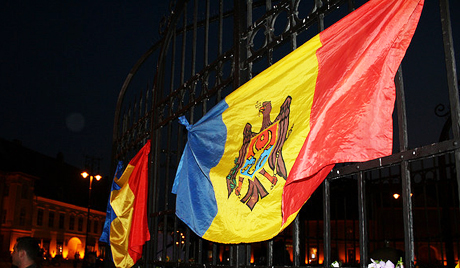
Moldova Between The EU and Russia
Publication: Eurasia Daily Monitor Volume: 8 Issue: 6
By:

Moldova’s Alliance for European Integration (AEI) has won a new, and potentially longer, lease on life, after 16 months of insecure governance (EDM, January 7). Its post-election government is due to be installed on January 14. The AEI’s success, however hard-won, shows the European Union’s gravitational attraction prevailing over Russia’s in Moldova. The EU and Russia had directly competed over the outcome of the electoral campaign and post-election coalition negotiations.
The Kremlin had sought to capitalize on Moldova’s uniquely resilient Communist Party. President Dmitry Medvedev’s administration coordinated Russian political operations in Moldova starting in the fall of 2009. Presidential administration head, Sergei Naryshkin, himself visited the country several times and also hosted a number of meetings in Moscow to broker a communist-based, left-of-center Moldovan government coalition.
Russia’s presidential administration has directly involved itself in all three parliamentary elections that were held in CIS countries during 2010: Ukraine, Kyrgyzstan, and Moldova. In each of the three cases, the presumed “progressive” Medvedev reached out to strengthen backward-looking, Soviet-bred political forces. Medvedev and Naryshkin liaised in Ukraine with Viktor Yanukovych, in Kyrgyzstan with Feliks Kulov, and in Moldova with Communist leader Vladimir Voronin, seeking to build post-election governments around these forces. Naryshkin also persuaded Moldovan Democratic Party leader and AEI presidential aspirant, Marian Lupu, to sign a partnership agreement with the United Russia party of power, in an attempt to split the AEI and prepare a communist-based coalition in Moldova.
Moldova’s communists, in power from 2001 to September 2009, fought the November 2010 electoral campaign as an opposition force, having lost the administrative resources and previous access to business donors. The party still took a distant first place (as it invariably has since 1998), albeit with a diminishing plurality and outvoted by AEI’s three parties combined. Of these, Lupu’s Democratic Party had played a Russian card from its birth in 2009, when it split off from the Communist Party to join the AEI. The new party positioned itself domestically as left-of-center, and in its foreign policy as equidistant between Europe and Russia. The Kremlin encouraged the formation of a Moldovan government coalition composed of the Communist Party and Democratic Party, so as to shut out the AEI from governmental power.
Naryshkin paid a post-election visit to Moldova in December 2010, in a final attempt to broker the formation of a Communist-Democratic Party coalition. In the elections’ aftermath, the Democratic Party held lengthy negotiations with AEI’s other two parties toward a center-right coalition, and in parallel with the communists moving to a center-left coalition. With its 15 parliamentary seats (out of AEI’s 59, in the 101-seat parliament), the Democratic Party became the balance holder; and Moscow had placed a hand on the fulcrum of that balance.
For its part, the EU redoubled its offers of European integration perspective, financial assistance, economic cooperation programs, and travel visa facilitation for Moldova. It also multiplied the visits of European officials to Chisinau, clearly demonstrating its preference for the AEI to win the election and form a durable government. These overtures significantly boosted the AEI during the electoral campaign and the lengthy post-election negotiations on forming a coalition government. During the post-election period alone, ministers of foreign affairs Carl Bildt of Sweden and Radoslaw Sikorski of Poland, Germany’s State Minister for Foreign Affairs Werner Hoyer, as well as European Commission officials descended on Chisinau; while the European Council President, Herman van Rompuy, European Commission President, Jose Manuel Barroso, and Enlargement and Neighborhood Commissioner, Stefan Fuele, among others, held talks with the AEI acting government’s leader, Vlad Filat, in Brussels (ADEPT Journal, December 16-31, 2010).
The EU’s message ultimately tipped the balance in AEI’s favor during the post-election stage. It holds out a realistic prospect of negotiating association and visa liberalization agreements, and a deep and comprehensive free-trade agreement between the EU and Moldova. The European Commission and a number of governments particularly in Central Europe regard Moldova as a potential “success story” for the EU’s Eastern Partnership Program. The AEI’s preservation as a three-party governing alliance became the prerequisite.
Lupu and his number two in the Democratic Party, the tycoon Vlad Plahotniuc, negotiated in both directions until the final legally permissible day, December 28. At that point, a party conference approved the decision to rejoin the AEI in a coalition government, with Lupu reconfirmed as the joint presidential candidate. Delegates from Naryshkin’s office attended this party conference but were unable to change its outcome (Moldpres, Unimedia, January 3-7).
Moscow has no outright pro-Russian party (apart from small fringe groups) to work with in right-bank Moldova (the situation is different in Transnistria). The most that Moscow can hope to achieve in Chisinau is a turn from the current Western orientation to a two-vector policy of equidistance between the West and Russia. The Kremlin had sought that outcome through a Communist-Democratic Party, center-left coalition, with the communists supplying the electoral mass and parliamentary base, while Lupu’s team would have added a European face and technical competence. Voronin’s party had shifted Moldova’s course from a Russian to a European orientation in 2004, but was shifting again by 2009. For his part, Lupu (irrespective of electoral calculations) can deliver little beyond symbolic gestures to Moscow in the new configuration of political power in Chisinau.
Meanwhile, Moscow and the Moldovan Communist Party deeply distrust each other, as do Tiraspol and the Moldovan communists. Voronin’s eight-year rule was marked by continuous tensions and periodic outbreaks of strife with Russia. The Kremlin apparently envisaged Lupu as a check on the unreliable Voronin in a center-left coalition. Such a coalition could have slowed down Moldova’s European course, to Moscow’s satisfaction. Russia cannot and does not seek to re-satellize Moldova at this stage. It is simply content to play spoiler through political operations in Chisinau and exploitation of the Transnistria conflict.




